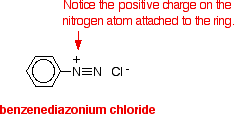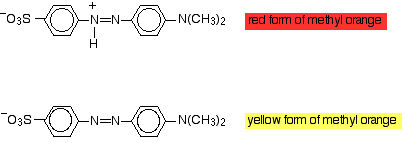Reactions of Diazonium Salts
- Page ID
- 3996
\( \newcommand{\vecs}[1]{\overset { \scriptstyle \rightharpoonup} {\mathbf{#1}} } \)
\( \newcommand{\vecd}[1]{\overset{-\!-\!\rightharpoonup}{\vphantom{a}\smash {#1}}} \)
\( \newcommand{\id}{\mathrm{id}}\) \( \newcommand{\Span}{\mathrm{span}}\)
( \newcommand{\kernel}{\mathrm{null}\,}\) \( \newcommand{\range}{\mathrm{range}\,}\)
\( \newcommand{\RealPart}{\mathrm{Re}}\) \( \newcommand{\ImaginaryPart}{\mathrm{Im}}\)
\( \newcommand{\Argument}{\mathrm{Arg}}\) \( \newcommand{\norm}[1]{\| #1 \|}\)
\( \newcommand{\inner}[2]{\langle #1, #2 \rangle}\)
\( \newcommand{\Span}{\mathrm{span}}\)
\( \newcommand{\id}{\mathrm{id}}\)
\( \newcommand{\Span}{\mathrm{span}}\)
\( \newcommand{\kernel}{\mathrm{null}\,}\)
\( \newcommand{\range}{\mathrm{range}\,}\)
\( \newcommand{\RealPart}{\mathrm{Re}}\)
\( \newcommand{\ImaginaryPart}{\mathrm{Im}}\)
\( \newcommand{\Argument}{\mathrm{Arg}}\)
\( \newcommand{\norm}[1]{\| #1 \|}\)
\( \newcommand{\inner}[2]{\langle #1, #2 \rangle}\)
\( \newcommand{\Span}{\mathrm{span}}\) \( \newcommand{\AA}{\unicode[.8,0]{x212B}}\)
\( \newcommand{\vectorA}[1]{\vec{#1}} % arrow\)
\( \newcommand{\vectorAt}[1]{\vec{\text{#1}}} % arrow\)
\( \newcommand{\vectorB}[1]{\overset { \scriptstyle \rightharpoonup} {\mathbf{#1}} } \)
\( \newcommand{\vectorC}[1]{\textbf{#1}} \)
\( \newcommand{\vectorD}[1]{\overrightarrow{#1}} \)
\( \newcommand{\vectorDt}[1]{\overrightarrow{\text{#1}}} \)
\( \newcommand{\vectE}[1]{\overset{-\!-\!\rightharpoonup}{\vphantom{a}\smash{\mathbf {#1}}}} \)
\( \newcommand{\vecs}[1]{\overset { \scriptstyle \rightharpoonup} {\mathbf{#1}} } \)
\( \newcommand{\vecd}[1]{\overset{-\!-\!\rightharpoonup}{\vphantom{a}\smash {#1}}} \)
\(\newcommand{\avec}{\mathbf a}\) \(\newcommand{\bvec}{\mathbf b}\) \(\newcommand{\cvec}{\mathbf c}\) \(\newcommand{\dvec}{\mathbf d}\) \(\newcommand{\dtil}{\widetilde{\mathbf d}}\) \(\newcommand{\evec}{\mathbf e}\) \(\newcommand{\fvec}{\mathbf f}\) \(\newcommand{\nvec}{\mathbf n}\) \(\newcommand{\pvec}{\mathbf p}\) \(\newcommand{\qvec}{\mathbf q}\) \(\newcommand{\svec}{\mathbf s}\) \(\newcommand{\tvec}{\mathbf t}\) \(\newcommand{\uvec}{\mathbf u}\) \(\newcommand{\vvec}{\mathbf v}\) \(\newcommand{\wvec}{\mathbf w}\) \(\newcommand{\xvec}{\mathbf x}\) \(\newcommand{\yvec}{\mathbf y}\) \(\newcommand{\zvec}{\mathbf z}\) \(\newcommand{\rvec}{\mathbf r}\) \(\newcommand{\mvec}{\mathbf m}\) \(\newcommand{\zerovec}{\mathbf 0}\) \(\newcommand{\onevec}{\mathbf 1}\) \(\newcommand{\real}{\mathbb R}\) \(\newcommand{\twovec}[2]{\left[\begin{array}{r}#1 \\ #2 \end{array}\right]}\) \(\newcommand{\ctwovec}[2]{\left[\begin{array}{c}#1 \\ #2 \end{array}\right]}\) \(\newcommand{\threevec}[3]{\left[\begin{array}{r}#1 \\ #2 \\ #3 \end{array}\right]}\) \(\newcommand{\cthreevec}[3]{\left[\begin{array}{c}#1 \\ #2 \\ #3 \end{array}\right]}\) \(\newcommand{\fourvec}[4]{\left[\begin{array}{r}#1 \\ #2 \\ #3 \\ #4 \end{array}\right]}\) \(\newcommand{\cfourvec}[4]{\left[\begin{array}{c}#1 \\ #2 \\ #3 \\ #4 \end{array}\right]}\) \(\newcommand{\fivevec}[5]{\left[\begin{array}{r}#1 \\ #2 \\ #3 \\ #4 \\ #5 \\ \end{array}\right]}\) \(\newcommand{\cfivevec}[5]{\left[\begin{array}{c}#1 \\ #2 \\ #3 \\ #4 \\ #5 \\ \end{array}\right]}\) \(\newcommand{\mattwo}[4]{\left[\begin{array}{rr}#1 \amp #2 \\ #3 \amp #4 \\ \end{array}\right]}\) \(\newcommand{\laspan}[1]{\text{Span}\{#1\}}\) \(\newcommand{\bcal}{\cal B}\) \(\newcommand{\ccal}{\cal C}\) \(\newcommand{\scal}{\cal S}\) \(\newcommand{\wcal}{\cal W}\) \(\newcommand{\ecal}{\cal E}\) \(\newcommand{\coords}[2]{\left\{#1\right\}_{#2}}\) \(\newcommand{\gray}[1]{\color{gray}{#1}}\) \(\newcommand{\lgray}[1]{\color{lightgray}{#1}}\) \(\newcommand{\rank}{\operatorname{rank}}\) \(\newcommand{\row}{\text{Row}}\) \(\newcommand{\col}{\text{Col}}\) \(\renewcommand{\row}{\text{Row}}\) \(\newcommand{\nul}{\text{Nul}}\) \(\newcommand{\var}{\text{Var}}\) \(\newcommand{\corr}{\text{corr}}\) \(\newcommand{\len}[1]{\left|#1\right|}\) \(\newcommand{\bbar}{\overline{\bvec}}\) \(\newcommand{\bhat}{\widehat{\bvec}}\) \(\newcommand{\bperp}{\bvec^\perp}\) \(\newcommand{\xhat}{\widehat{\xvec}}\) \(\newcommand{\vhat}{\widehat{\vvec}}\) \(\newcommand{\uhat}{\widehat{\uvec}}\) \(\newcommand{\what}{\widehat{\wvec}}\) \(\newcommand{\Sighat}{\widehat{\Sigma}}\) \(\newcommand{\lt}{<}\) \(\newcommand{\gt}{>}\) \(\newcommand{\amp}{&}\) \(\definecolor{fillinmathshade}{gray}{0.9}\)This page looks at some typical reactions of diazonium ions, including examples of both substitution reactions and coupling reactions. If you have come straight to this page from a search engine and want to know about the preparation of the diazonium ions.
Substitution reactions of diazonium ions
Diazonium ions are present in solutions such as benzenediazonium chloride solution. They contain an -N2+ group. In the case of benzenediazonium chloride, this is attached to a benzene ring. Benzenediazonium chloride looks like this:

In this set of reactions of the diazonium ion, the -N2+ group is replaced by something else. The nitrogen is released as nitrogen gas.
Substitution by an -OH group
To get this reaction, all you need to do is warm the benzenediazonium chloride solution. The diazonium ion reacts with the water in the solution and phenol is formed - either in solution or as a black oily liquid (depending on how much is formed). Nitrogen gas is evolved.
![]()

This is the same reaction that you get if you react phenylamine with nitrous acid in the warm. The diazonium ion is formed first and then immediately reacts with the water in the solution to give phenol.
Substitution by an iodine atom
This is a good example of the use of diazonium salts to substitute things into a benzene ring which are otherwise quite difficult to attach. (That's equally true of the previous reaction, by the way.) If you add potassium iodide solution to the benzenediazonium chloride solution in the cold, nitrogen gas is given off, and you get oily droplets of iodobenzene formed.
There is a simple reaction between the diazonium ions and the iodide ions from the potassium iodide solution.
![]()

Coupling reactions of diazonium ions
In the substitution reactions above, the nitrogen in the diazonium ion is lost. In the rest of the reactions on this page, the nitrogen is retained and used to make a bridge between two benzene rings.
The reaction with phenol
Phenol is dissolved in sodium hydroxide solution to give a solution of sodium phenoxide.
![]()

The solution is cooled in ice, and cold benzenediazonium chloride solution is added. There is a reaction between the diazonium ion and the phenoxide ion and a yellow-orange solution or precipitate is formed. The product is one of the simplest of what are known as azo compounds, in which two benzene rings are linked by a nitrogen bridge.
![]()

The reaction with naphthalen-2-ol
Naphthalen-2-ol is also known as 2-naphthol or beta-naphthol. It contains an -OH group attached to a naphthalene molecule rather than to a simple benzene ring. Naphthalene has two benzene rings fused together. The reaction is done under exactly the same conditions as with phenol. The naphthalen-2-ol is dissolved in sodium hydroxide solution to produce an ion just like the phenol one. This solution is cooled and mixed with the benzenediazonium chloride solution.
An intense orange-red precipitate is formed - another azo compound.
![]()

The reaction with phenylamine (aniline)
Some liquid phenylamine is added to a cold solution of benzenediazonium chloride, and the mixture is shaken vigorously. A yellow solid is produced.

These strongly coloured azo compounds are frequently used as dyes known as azo dyes. The one made from phenylamine (aniline) is known as "aniline yellow" (amongst many other things - see note above). Azo compounds account for more than half of modern dyes.
The use of an azo dye as an indicator - methyl orange
Azo compounds contain a highly delocalized system of electrons which takes in both benzene rings and the two nitrogen atoms bridging the rings. The delocalization can also extend to things attached to the benzene rings as well. If white light falls on one of these molecules, some wavelengths are absorbed by these delocalized electrons. The colour you see is the result of the non-absorbed wavelengths. The groups which contribute to the delocalization (and so to the absorption of light) are known as a chromophore.
Modifying the groups present in the molecule can have an effect on the light absorbed, and so on the color you see. You can take advantage of this in indicators. Methyl orange is an azo dye which exists in two forms depending on the pH:

As the hydrogen ion is lost or gained there is a shift in the exact nature of the delocalisation in the molecule, and that causes a shift in the wavelength of light absorbed. Obviously that means that you see a different colour. When methyl orange is added, a hydrogen ion attaches to give the red form. Methyl orange is red in acidic solutions (in fact solutions of pH less than 3.1). If an alkali is added or hydrogen ions are removed, then the yellow form if generated. Methyl orange is yellow at pH's greater than 4.4.
In between, at some point there will be equal amounts of the red and yellow forms and so methyl orange looks orange.
Contributors
Jim Clark (Chemguide.co.uk)


